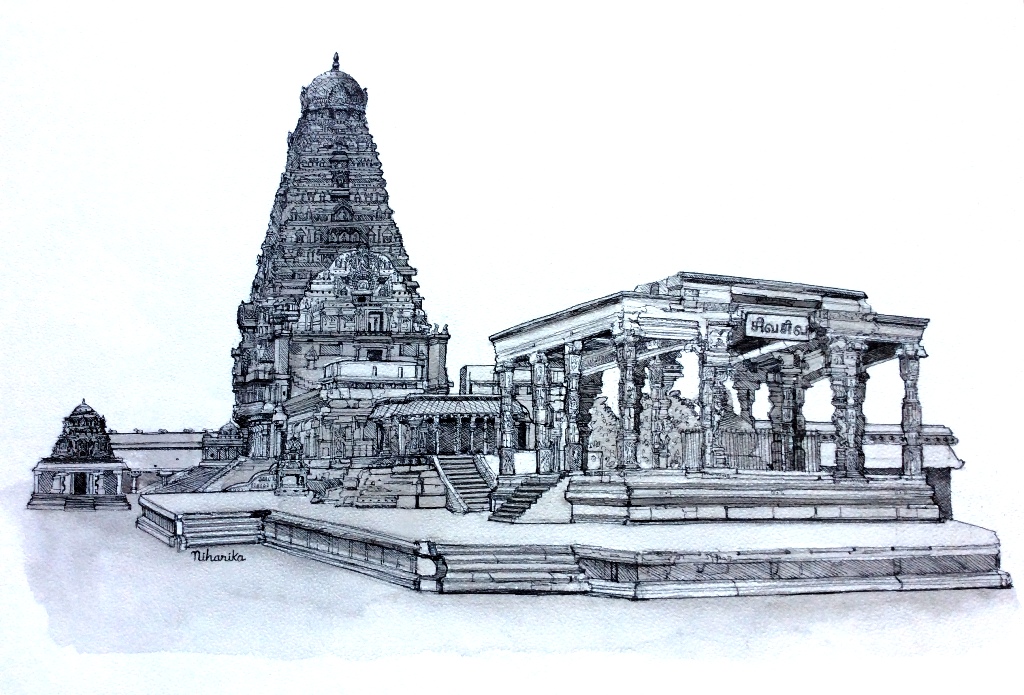Sketching the Qutub Minar in Delhi
 |
| A Black and White illustration of the Qutub Minar |
One of the highlights of that trip was a walk from Saket to a tall tower that called out from way over there in the distance - the Qutub Minar.
 |
| A pen and watercolor sketch of the Qutub Minar |
I was worried if I was on the right road, despite very clear instructions on how to go but it turns out I needn't have worried. The Qutub Minar is tall enough to be seen for miles and I only had to continue on the same road. I have seen the Qutub Minar before but this time I was older, a tad more conscious, and alone. And I had a distinct purpose in my mind - to sketch the Qutub Minar.
It was hidden in parts by the morning mist, while I took my time ambling along. I passed a tree that had shed its leaves and grown pigeons! Well, that's what it looked like because there were hundreds of them. Not just on the tree, but on electricity poles, lines, rooftops and pavements. Looks like they rule the roost! A dog slept amid them unconcerned.
I knew I was closer to my destination when I saw unmistakable signs of that dreaded but necessary species of mankind - the tourists. Cameras slung across shoulders, kids in tow, hats in place, fashionable mufflers and hand gloves, and sunglasses ranging from the cool to the comical. The closer I got, the more the variety. Dapper well-groomed guides speaking a variety of tongues shepherding Korean, French, Italian, Arab and American tourists. Suspicious travelers from different countries refusing the advances of local touts, content with their Lonely Planet guidebooks and an astonishingly good ability to blend in with the crowd. School children screaming, laughing and horsing around while their weary teachers looked elsewhere.
When I did enter the Qutub Minar complex, I stepped back in awe. I shaded my eyes from the blinding sun that had crept up behind it. What I admire the most is the gorgeous calligraphy - beautifully spaced out and minutely detailed - I read in this interesting blog about how Islamic calligraphy is the main medium of artistic expression, as a way to avoid representing human forms.This resulted in an emphasis on construction, line work and intricate design in Islamic Art and Architecture. That must be how they got such deep understanding of how geometry works - not just in the symmetry of the designs but in the entire structure. For instance, the Qutub Minar is made of several superimposed shafts, all separated by storeyed balconies.
The Qutub complex is one of the earliest examples of Indo - Islamic architecture. I walked around, , momentarily distracted from the monument in my efforts to find a less crowded spot where I could sketch in peace. And I found my vantage point - A nice little corner overlooking the Qutub Minar with only a pair of pigeons and the smell of bats for company. I loved the challenge of squeezing one of the world's tallest structures in a small sketchbook that is no bigger than the palm of my hand!I get right down to it and here's the finished sketch -
 |
| On the spot sketching |
Next, I moved on to sketch the Tomb of Iltutmish. The tomb of Shams-Ud-Din Iltutmish is simple on the outside. The interiors are much more elaborately designed. Intricate carvings and Calligraphy adorn the walls.
 |
| The tomb of Iltutmish - sketch |
 |
| Finished watercolor sketch - Tomb of Iltutmish |
Watch the process video of the black and white illustration of Qutub Minar below :)
Thanks for reading and watching!



Comments
Post a Comment